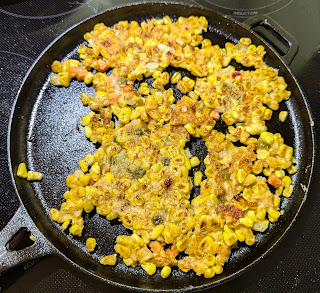The Kidlet loves French toast. (And strawberry jam, for that matter.) So I figured the idea of French toast stuffed with cream cheese and strawberry jam would be a big hit. And it was!
I think the concept for this recipe is sound. I just question their instructions.
As written, the recipe recommends using one loaf of challah and cutting it into six 6-cm thick slices. Now, first of all, even considering that you'll be suffing the slices, that is insanely thick. And, secondly, how big are their loaves of challah that you can
get six 6-cm slices out of one loaf? That would mean that the whole loaf would have to be a little over 36cm long! (A little over, because you need to trim the heels off.) I consider a "standard" loaf pan to be between 20 and 23cm long. So, that is one
monster loaf of bread they have there.
I asked TF to cut our loaf into four 5-cm thick slices. And even those were (in my opinion) still much too thick. I'd definitely go for five 4-cm slices next time. And TF thinks that those might be too thick even still. She suggested that 3-cm slices might be more appropriate. And, honestly, I think she might be right. That said, I'd want to try it with 4-cm slices first and see how that works out before moving down to even thinner slabs of bread.
Given that we ended up with only four slices for our rendition of this recipe today, I reduced the amount of custard and filling somewhat. However, since I'm writing up the recipe for a larger number of thinner slices, I've scaled the filling and custard amounts back up. Hopefully these amounts should be about right, but feel free to play around with the proportions a bit.
French Toast Stuffed with Cream Cheese and Strawberry Jam
Slightly adapted from The Breakfast Bible by Kate McMillan
Ingredients
- 1 loaf of bread1
- 170g cream cheese, softened
- 1/3 c. strawberry jam
- 5 large eggs
- 1 1/4 c. milk
- 1 tsp. vanilla extract
- 1 Tbsp. butter, divided
- maple syrup, to serve
Directions
- Trim off the heels and cut the bread into five or six very thick slices (3-4cm each).
- Cut a slit into the top of each slice of bread to form a pocket that extends through the centre of the slice to within ~2cm of each of the other three sides.
- Combine the jam and cream cheese and mix well.
- Carefully spoon some of the cream cheese mixture into each bread pocket, doing your best to divide it evenly.
- Beat the eggs with the milk and vanilla.
- Melt ~1/2 a tsp. of butter over medium-low heat.
- Dip one stuffed bread slice into the custard to thoroughly coat the outside.
- Place it in the pan and cook until underside is golden brown. Flip and cook until other side is similarly golden.
- Repeat cooking process with remaining slices.
- Serve topped with maple syrup.
Variants
French Toast Stuffed with Mascarpone and Apricot Jam
Ingredients
- 1 loaf of bread
- 170g mascarpone
- 1/3 c. apricot jam
- 5 large eggs
- 1 1/4 c. milk
- 1 tsp. vanilla extract
- 1 Tbsp. butter, divided
- maple syrup, to serve
French Toast Stuffed with Banana and Nutella
Ingredients
- 1 loaf of bread
- 1 banana, mashed
- 1/3 c. Nutella
- 5 large eggs
- 1 1/4 c. milk
- 1 tsp. vanilla extract
- 1 Tbsp. butter, divided
- maple syrup, to serve
A relatively close-grained bread will be best for this. Something with a fairly light, but fine crumb so that the filling won't leak out. Challah, brioche, and pain de mie are all good choices. I used a loaf of
Sister Virginia's bread based on a 19th century Shaker recipe. It is a fairly basic white bread very slightly enriched with a bit of milk, sugar, and lard. But anything that's not too heavy, too open, or too savoury would work well here.
Back





















